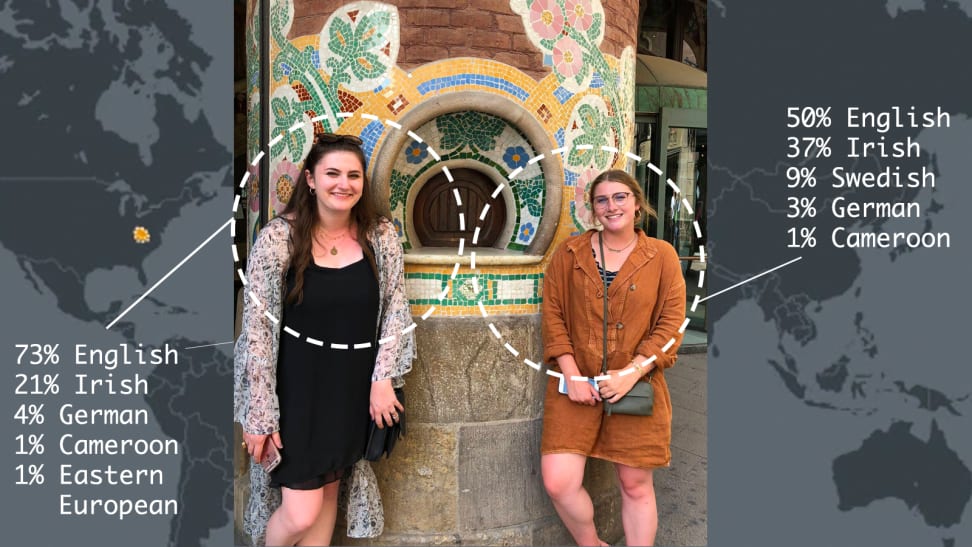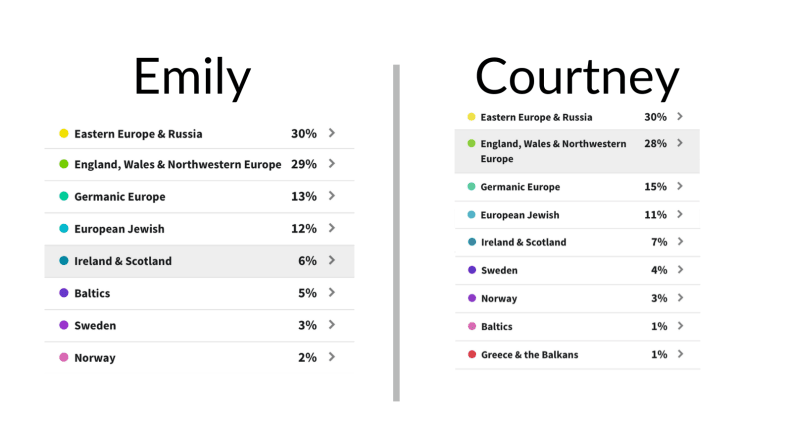Do siblings get the same DNA results? We found out
How different could your DNA really be?
 Credit:
Reviewed
Credit:
Reviewed
Products are chosen independently by our editors. Purchases made through our links may earn us a commission.
Looking into your ancestry can take many forms, from consulting the family photo albums to taking a DNA test to even making a family tree. Our editors are big fans of AncestryDNA, which allows you to take comprehensive DNA tests, track your ancestry, and now, even monitor your health.
One of the best aspects of AncestryDNA is its ability to let you peer into your family's history and see which countries and regions you come from, but your DNA alone won't necessarily paint the entire picture of your family's origins. Often, people take DNA tests in pairs, to see how closely aligned their DNA is with that of a sibling or cousin. But, is it worth it to have a sibling take a DNA test if you have, and vice versa? We talked to some experts and compared some sibling results—here's what you should know.
Who took the test?

I'll never not be holding a coffee cup, ok?
My name is Madison Durham and I'm a senior writer for Reviewed. My sister Jenna and I took DNA tests through Ancestry. We're a few years apart in age, but we look nothing alike. She's blonde and blue-eyed, and I have dark hair and dark eyes. We had some unified expectations for the regions the test would identify, as well as a sense of timeline attached to our family's European migration. We knew that the test would likely inform us that our family had come over to the United States in the 1700s and settled in West Virginia (it did) and that we came from England and Germany (it sort of did).

Yes, they're related. Shocking, right?
Two of my editors also completed AncestryDNA tests with their siblings and contributed their findings. Kate Tully Ellsworth, our executive editor of parnter content, took a DNA test along with her brother. They are four years apart and they look moderately similar. Both have brown hair, but Kate has blue eyes, while her brother Chris has brown eyes. He is taller, about 5'8", while she is shorter, about 5'2". They knew they'd have Irish heritage, but the rest was a mystery. Like many others, they grew up being told they had distant Native American roots, so they were eager to see if this was fact or family lore.

Courtney and Emily have many things in common—namely, they're both incredibly stylish.
Our former shopping editor Courtney Campbell and her sister Emily took tests, as well. They are two years apart, but don’t necessarily look related unless you throw them in a family photo (Courtney looks more like their dad while Emily took on their mom’s looks), so they were especially curious how similar their results would be. Emily has year-long tanned skin, brown eyes, and wavy, brown hair (that was curly and blonde as a child), and Courtney has fairer skin, green eyes, and blonde, curly hair. Their dad was adopted, but their mom has English, Czech, and German heritage, so determining their actual ancestry was the main factor in getting the test.
Using results from all three pairs of siblings, we dug into whether our results were similar, and if not, how different they really were. As with any DNA journey, we came across surprises about our own geneology, but also confirmed facts we already knew about ourselves (like Kate and her brother are not, in fact, Native American). [Editor's Note: Told you, mom.]
What were the results?

Jenna and Madison had similar ethnicities, but different percentages.
Madison: Between my sister and I, the results of the test were pretty much the same in terms of which countries of origin the test picked out, but our percentages varied pretty heavily. For example, while my percentage for England, Wales, and Northwestern Europe was listed as 73%, my sister's was 50%. Ancestry indicates that the Ethnicity Estimates are just that, estimates, and that variation on your actual percentages is a given.
Our DNA results also indicated similar relatives, and my sister's test was very similar to that of our great uncle on my mother's side. One interesting element of Ancestry is the ability to reach out to matches, and since we both took the test my sister and I have received messages from different people trying to trace where the family tree links are coming from. It's been interesting to see which people out of our DNA matches reach out to us.

Chris and Kate had similar results, but Kate is, somehow, French and German.
Kate: Like me and Jenna, Kate and Chris shared some of the same ethnicity profiles, but with varying percentages. Kate is 70% English and 21% Irish, whie Chris is 62% English and 38% Irish. Kate is also, apparently, part German and French, while Chris is neither. Neither Kate nor Chris are aware of any distant French or German ancestors, but both were intrigued—and curious as to how Chris didn't register either ethnicity in his DNA results.

Courtney and Emily share DNA across a variety of ethnicities.
Courtney: Courtney is a self-described European mutt, so she did not find her results surprising. She and Emily both have a healthy mix of European heritage from multiple countries, and their percentages are remarkably similar across the board.
Most surprisingly, Emily and Courtney took their tests together a few years ago (they exchanged tests for the holidays). At the time, both tests showed that they had Scandanavian roots—something Emily in particular found exciting. But when she re-checked her results for the publication of this piece, her Scandanavian roots had disappeared.
Why? It turns out your results on Ancestry can change over time, so as more people use AncestryDNA and upload their results, the more accurate your estimate can become. So while it may have registered Emily as having Scandanavian heritage a few years ago, it has further refined its matching system and more accurately attributed her roots. Courtney notes that this is still a sore spot for Emily (sorry, Emily).
Overall, the results were the same across the board—our results were definitely different from our siblings', but not so different that you couldn't identify that we were siblings. We shared major ethnicities across the board with varying percentages. We feel confident that if you spotted all six tests with our names removed, you'd easily be able to pair siblings together looking at ethnicities alone. We also agreed it was fascinating to see not only our own heritages, but how they impacted our individual make-up and potentially impacted our differing physical characteristics.
What does Ancestry recommend regarding testing siblings?

AncestryDNA kits will show different results for different people. Why? Science.
Is it fun to get a DNA test with your sibling? Yes. It is necessary to understand the full scope of your heritage? That answer is less black-and-white.
In a blog post, Ancestry noted that DNA inheritance involves a bit of randomness, and that randomness tends to come out when siblings are tested together. If you're an identical twin, a DNA test is unlikely to reveal any different information between you and your sibling, but between siblings, there can be a lot of differences. Ancestry indicated that testing your sibling's DNA might be able to reveal new cousins and insights into historical communities. However, it was also noted that testing a parent or older relative might reveal more about your lineage and your family than testing a sibling could.
What do the experts say?
I connected with Mark Seeger, an Associate Professor of Molecular Genetics at The Ohio State University on this one, to see what his take was on sibling DNA tests. Professor Seeger indicated that while you and a sibling might individually benefit from taking your own DNA tests, a sibling's DNA test will vary pretty greatly from your own, with your shared DNA averaging out around 50%.
Ultimately, he agreed with Ancestry’s breakdown of sibling DNA and indicated that while it’s interesting to have a sibling take a DNA test with you, having your mother or father take the test might shed more light on your particular DNA story and heritage. He also mentioned that if siblings are male and female, having the male sibling take a test as well can help indicate what a father might be contributing to the gene pool better than a female sibling's results could.
Should your sibling get a DNA test if you did?

They may be siblings, but only one is French.
Ultimately, we wish that our parents would have taken the DNA test too, so that we could get a better sense of where certain elements of the breakdown were coming from. For example, I had a nearly identical chart to one of my cousins who’d also had their DNA analyzed, but my sister’s chart was very different. It would have been cool to learn if my mother's DNA test lined up with mine and the cousin's, since he's on her side of the family, or if our mother and father's sides are really similar in terms of countries of origin and history.
One cool thing about AncestryDNA is that if your parents take a test, Ancestry will be able to inform you if cousins and relatives that appear in your matches are from your mother's side or your father's side. If you're looking into your family tree and working on building out your connections to your matches, this could be extremely valuable and is well worth looking into. What's more, Ancestry also recommends testing your oldest family member first if you're planning on looking into "who came from where," so consider gifting the DNA kit to grandma instead of your sibling.
Taking tests with our siblings was an incredibly fun and informative experience. Would we do it again? Absolutely. Was it completely necessary to grasp our heritages? No. It boils down to what your reasons are for taking a DNA test in the first place.
